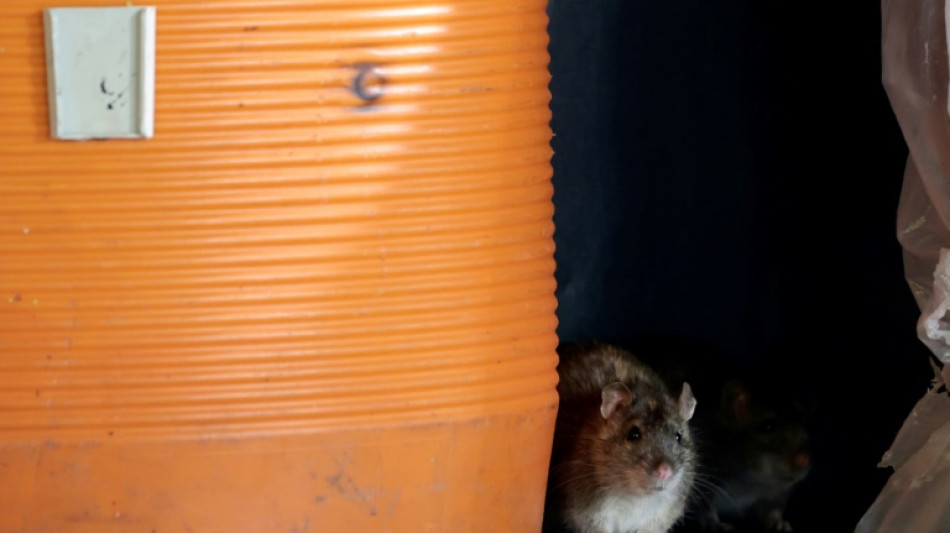
-
 Stock market optimism returns after tech selloff but Wall Street wobbles
Stock market optimism returns after tech selloff but Wall Street wobbles
-
Clarke warns Scotland fans over sky-high World Cup prices

-
 In Israel, Sydney attack casts shadow over Hanukkah
In Israel, Sydney attack casts shadow over Hanukkah
-
Son arrested after Rob Reiner and wife found dead: US media

-
 Athletes to stay in pop-up cabins in the woods at Winter Olympics
Athletes to stay in pop-up cabins in the woods at Winter Olympics
-
England seek their own Bradman in bid for historic Ashes comeback

-
 Decades after Bosman, football's transfer war rages on
Decades after Bosman, football's transfer war rages on
-
Ukraine hails 'real progress' in Zelensky's talks with US envoys

-
 Nobel winner Machado suffered vertebra fracture leaving Venezuela
Nobel winner Machado suffered vertebra fracture leaving Venezuela
-
Stock market optimism returns after tech sell-off

-
 Iran Nobel winner unwell after 'violent' arrest: supporters
Iran Nobel winner unwell after 'violent' arrest: supporters
-
Police suspect murder in deaths of Hollywood giant Rob Reiner and wife

-
 'Angry' Louvre workers' strike shuts out thousands of tourists
'Angry' Louvre workers' strike shuts out thousands of tourists
-
EU faces key summit on using Russian assets for Ukraine

-
 Maresca committed to Chelsea despite outburst
Maresca committed to Chelsea despite outburst
-
Trapped, starving and afraid in besieged Sudan city

-
 Showdown looms as EU-Mercosur deal nears finish line
Showdown looms as EU-Mercosur deal nears finish line
-
Messi mania peaks in India's pollution-hit capital

-
 Wales captains Morgan and Lake sign for Gloucester
Wales captains Morgan and Lake sign for Gloucester
-
Serbian minister indicted over Kushner-linked hotel plan

-
 Eurovision 2026 will feature 35 countries: organisers
Eurovision 2026 will feature 35 countries: organisers
-
Cambodia says Thailand bombs province home to Angkor temples

-
 US-Ukrainian talks resume in Berlin with territorial stakes unresolved
US-Ukrainian talks resume in Berlin with territorial stakes unresolved
-
Small firms join charge to boost Europe's weapon supplies

-
 Driver behind Liverpool football parade 'horror' warned of long jail term
Driver behind Liverpool football parade 'horror' warned of long jail term
-
German shipyard, rescued by the state, gets mega deal

-
 Flash flood kills dozens in Morocco town
Flash flood kills dozens in Morocco town
-
'We are angry': Louvre Museum closed as workers strike

-
 Australia to toughen gun laws as it mourns deadly Bondi attack
Australia to toughen gun laws as it mourns deadly Bondi attack
-
Stocks diverge ahead of central bank calls, US data

-
 Wales captain Morgan to join Gloucester
Wales captain Morgan to join Gloucester
-
UK pop star Cliff Richard reveals prostate cancer treatment

-
 Mariah Carey to headline Winter Olympics opening ceremony
Mariah Carey to headline Winter Olympics opening ceremony
-
Indonesia to revoke 22 forestry permits after deadly floods

-
 Louvre Museum closed as workers strike
Louvre Museum closed as workers strike
-
Spain fines Airbnb 64 mn euros for posting banned properties

-
 Japan's only two pandas to be sent back to China
Japan's only two pandas to be sent back to China
-
Zelensky, US envoys to push on with Ukraine talks in Berlin

-
 Australia to toughen gun laws after deadly Bondi shootings
Australia to toughen gun laws after deadly Bondi shootings
-
Lyon poised to bounce back after surprise Brisbane omission

-
 Australia defends record on antisemitism after Bondi Beach attack
Australia defends record on antisemitism after Bondi Beach attack
-
US police probe deaths of director Rob Reiner, wife as 'apparent homicide'

-
 'Terrified' Sydney man misidentified as Bondi shooter
'Terrified' Sydney man misidentified as Bondi shooter
-
Cambodia says Thai air strikes hit home province of heritage temples

-
 EU-Mercosur trade deal faces bumpy ride to finish line
EU-Mercosur trade deal faces bumpy ride to finish line
-
Inside the mind of Tolkien illustrator John Howe

-
 Mbeumo faces double Cameroon challenge at AFCON
Mbeumo faces double Cameroon challenge at AFCON
-
Tongue replaces Atkinson in only England change for third Ashes Test

-
 England's Brook vows to rein it in after 'shocking' Ashes shots
England's Brook vows to rein it in after 'shocking' Ashes shots
-
Bondi Beach gunmen had possible Islamic State links, says ABC

| RYCEF | 2.01% | 14.9 | $ | |
| RBGPF | -4.49% | 77.68 | $ | |
| CMSC | 0.02% | 23.305 | $ | |
| SCS | 0.12% | 16.14 | $ | |
| BCC | -1.23% | 75.58 | $ | |
| CMSD | 0.26% | 23.31 | $ | |
| GSK | 0.65% | 49.13 | $ | |
| NGG | 0.9% | 75.61 | $ | |
| RIO | -0.25% | 75.473 | $ | |
| BCE | 0.77% | 23.575 | $ | |
| AZN | 1.39% | 91.1 | $ | |
| JRI | 0.17% | 13.59 | $ | |
| RELX | 1.82% | 41.13 | $ | |
| VOD | 1.22% | 12.745 | $ | |
| BTI | 0.76% | 57.535 | $ | |
| BP | -0.38% | 35.125 | $ |

Forget mammoths, study shows how to resurrect Christmas Island rats
Ever since the movie Jurassic Park, the idea of bringing extinct animals back to life has captured the public's imagination -- but what might scientists turn their attention towards first?
Instead of focusing on iconic species like the woolly mammoth or the Tasmanian tiger, a team of paleogeneticists have studied how, using gene editing, they could resurrect the humble Christmas Island rat, which died out around 120 years ago.
Though they did not follow through and create a living specimen, they say their paper, published in Current Biology on Wednesday, demonstrates just how close scientists working on de-extinction projects could actually get using current technology.
"I am not doing de-extinction, but I think it's a really interesting idea, and technically it's really exciting," senior author Tom Gilbert, an evolutionary geneticist at the University of Copenhagen, told AFP.
There are three pathways to bringing back extinct animals: back-breeding related species to achieve lost traits; cloning, which was used to create Dolly the sheep in 1996; and finally genetic editing, which Gilbert and colleagues looked at.
The idea is to take surviving DNA of an extinct species, and compare it to the genome of a closely-related modern species, then use techniques like CRISPR to edit the modern species' genome in the places where it differs.
The edited cells could then be used to create an embryo implanted in a surrogate host.
Gilbert said old DNA was like a book that has gone through a shredder, while the genome of a modern species is like an intact "reference book" that can be used to piece together the fragments of its degraded counterpart.
His interest in Christmas Island rats was piqued when a colleague studied their skins to look for evidence of pathogens that caused their extinction around 1900.
It's thought that black rats brought on European ships wiped out the native species, described in an 1887 entry of the Proceedings of the Zoological Society of London as a "fine new Rat," large in size with a long yellow-tipped tail and small rounded ears.
- Key functions lost -
The team used brown rats, commonly used in lab experiments, as the modern reference species, and found they could reconstruct 95 percent of the Christmas Island rat genome.
That may sound like a big success, but the five percent they couldn't recover was from regions of the genome that controlled smell and immunity, meaning that the recovered rat might look the same but would lack key functionality.
"The take home is, even if we have basically the perfect ancient DNA situation, we've got a really good sample, we've sequenced the hell out of it, we're still lacking five percent of it," said Gilbert.
The two species diverged around 2.6 million years ago: close in evolutionary time, but not close enough to fully reconstruct the lost species' full genome.
This has important implications for de-extinction efforts, such as a project by US bioscience firm Colossal to resurrect the mammoth, which died out around 4,000 years ago.
Mammoths have roughly the same evolutionary distance from modern elephants as brown rats and Christmas Island rats.
Teams in Australia meanwhile are looking at reviving the Tasmanian tiger, or thylacine, whose last surviving member died in captivity in 1936.
Even if gene-editing were perfected, replica animals created with the technique would thus have certain critical deficiencies.
"Let's say you're bringing back a mammoth solely to have a hairy elephant in a zoo to raise money or get conservation awareness -- it doesn't really matter," he said.
But if the goal is to bring back the animal in its exact original form "that's never going to happen," he said.
Gilbert admitted that, while the science was fascinating, he had mixed feelings on de-extinction projects.
"I'm not convinced it is the best use of anyone's money," he said. "If you had to choose between bringing back something or protecting what was left, I'd put my money into protection."
A.Taylor--AT




